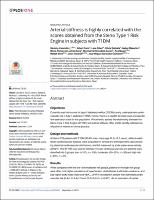| dc.contributor | Vall d'Hebron Barcelona Hospital Campus |
| dc.contributor.author | Llauradó Cabot, Gemma |
| dc.contributor.author | Cano, Albert |
| dc.contributor.author | Albert, Lara |
| dc.contributor.author | Ballesta, Silvia |
| dc.contributor.author | Mazarico, Isabel |
| dc.contributor.author | Luchtenberg, María F. |
| dc.contributor.author | Simó Canonge, Rafael |
| dc.date.accessioned | 2020-03-17T07:09:12Z |
| dc.date.available | 2020-03-17T07:09:12Z |
| dc.date.issued | 2019-09-04 |
| dc.identifier.citation | Llauradó G, Cano A, Albert L, Ballesta S, Mazarico I, Luchtenberg MF, et al. Arterial stiffness is highly correlated with the scores obtained from the Steno Type 1 Risk Engine in subjects with T1DM. PLoS One. 2019 Sep 4;14(9):e0220206. |
| dc.identifier.issn | 1932-6203 |
| dc.identifier.uri | https://hdl.handle.net/11351/4733 |
| dc.description | Steno Type 1 Risk Engine (ST1RE); Arterial stiffness; Type 1 diabetes (T1DM) |
| dc.description.abstract | OBJECTIVES:
Currently used risk scores for type 2 diabetes mellitus (T2DM) clearly underestimate cardiovascular risk in type 1 diabetes (T1DM). Hence, there is a need to develop novel and specific risk-estimation tools for this population. We aimed to assess the relationship between the Steno Type 1 Risk Engine (ST1RE) and arterial stiffness (AS), and to identify potential cut-off points of interest in clinical practice.
DESIGN AND METHODS:
A total of 179 patients with T1DM (50.8% men, mean age 41.2±13.1 years), without established cardiovascular disease, were evaluated for clinical and anthropometric data (including classical cardiovascular risk factors), and AS measured by aortic pulse-wave velocity (aPWV). The ST1RE was used to estimate 10-year cardiovascular risk and patients were classified into 3 groups: low- (<10%; n = 105), moderate- (10-20%; n = 53) and high-risk (≥20%; n = 21).
RESULTS:
When compared with the low- and moderate-risk groups, patients in the high-risk group were older, had higher prevalence of hypertension, dyslipidemia and insulin-resistance, and had higher body-mass index and HbA1c. aPWV increased in parallel with estimated cardiovascular risk (6.4±1.0, 8.4±1.3 and 10.3±2.6m/s; p<0.001). As an evaluation of model performance, the C-statistic of aPWV was 0.914 (95% confidence interval [CI]:0.873-0.950) for predicting moderate/high-risk and 0.879 (95%CI:0.809-0.948) for high-risk, according to the ST1RE. The best cut-off points of aPWV were 7.3m/s (sensitivity:86%, specificity:83%) and 8.7m/s (sensitivity:76%, specificity:86%) for moderate/high- and high-risk, respectively.
CONCLUSIONS:
AS is highly correlated with the scores obtained from the ST1RE. We have identified two cut-off points of AS that can clearly discriminate moderate/high- and high-risk T1DM patients, which could be of great value in clinical practice. |
| dc.language.iso | eng |
| dc.publisher | Public Library Science |
| dc.relation.ispartofseries | PLoS ONE;14(9) |
| dc.rights | Attribution 4.0 International |
| dc.rights.uri | http://creativecommons.org/licenses/by/4.0/ |
| dc.source | Scientia |
| dc.subject | Endoteli vascular |
| dc.subject | Diabetis |
| dc.subject | Medicina - Informàtica |
| dc.subject.mesh | Vascular Stiffness |
| dc.subject.mesh | Diabetes Mellitus, Type 1 |
| dc.subject.mesh | Medical Informatics Applications |
| dc.title | Arterial stiffness is highly correlated with the scores obtained from the Steno Type 1 Risk Engine in subjects with T1DM |
| dc.type | info:eu-repo/semantics/article |
| dc.identifier.doi | 10.1371/journal.pone.0220206 |
| dc.subject.decs | rigidez vascular |
| dc.subject.decs | diabetes mellitus tipo I |
| dc.subject.decs | aplicaciones de la informática médica |
| dc.relation.publishversion | https://journals.plos.org/plosone/article?id=10.1371/journal.pone.0220206#sec018 |
| dc.type.version | info:eu-repo/semantics/publishedVersion |
| dc.audience | Professionals |
| dc.contributor.authoraffiliation | [Llauradó G] Department of Endocrinology and Nutrition, Hospital del Mar, Institut Hospital del Mar d'Investigacions Mèdiques (IMIM), Barcelona, Spain. IISPV Pere Virgili Health Research Institute, Tarragona, Spain. Centro de Investigación Biomédica en Red de Diabetes y Enfermedades Metabólicas Asociadas (CIBERDEM), Instituto de Salud Carlos III, Madrid, Spain. [Cano A, Albert L, Mazarico I, Luchtenberg MF] Department of Endocrinology and Nutrition, Parc Taulí Hospital Universitari, Institut d'Investigació i Innovació Parc Taulí I3PT, Sabadell, Spain. Universitat Autònoma de Barcelona, Sabadell, Spain. [Ballesta S] Department of Endocrinology and Nutrition, Hospital del Mar, Institut Hospital del Mar d'Investigacions Mèdiques (IMIM), Barcelona, Spain. [Simó R] Centro de Investigación Biomédica en Red de Diabetes y Enfermedades Metabólicas Asociadas (CIBERDEM), Instituto de Salud Carlos III, Madrid, Spain. Grup de Recerca en Diabetes i Metabolisme, Vall d’Hebron Insitut de Recerca (VHIR), Barcelona, Spain. Universitat Autònoma de Barcelona, Barcelona, Spain |
| dc.identifier.pmid | 31483791 |
| dc.identifier.wos | 000486313000011 |
| dc.relation.projectid | info:eu-repo/grantAgreement/ES/6PN/PI12%2F00954 |
| dc.relation.projectid | info:eu-repo/grantAgreement/ES/6PN/PI09%2F01360 |
| dc.relation.projectid | info:eu-repo/grantAgreement/ES/PE2013-2016/PI15%2F00567 |
| dc.rights.accessrights | info:eu-repo/semantics/openAccess |

